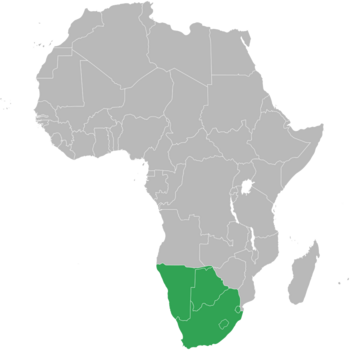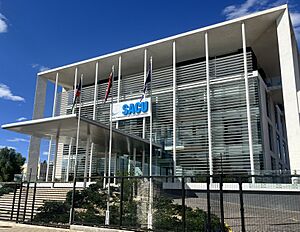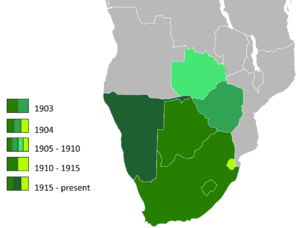Southern African Customs Union facts for kids
Quick facts for kids
Southern African Customs Union
|
|
|---|---|

Members of the SACU
|
|
| Headquarters | Windhoek |
| Largest city | Johannesburg |
| Official language | English (de facto)a |
| Demonym(s) | Southern African |
| Type | Customs union |
| Membership |
5 states
|
| Leaders | |
|
• SACU Chair
|
|
|
• SACU Executive Secretary
|
T.D. Khasipe |
| Establishment | 1910 |
| Area | |
|
• Total
|
2,672,830 km2 (1,031,990 sq mi) |
| Population | |
|
• 2021 estimate
|
|
| GDP (PPP) | 2021 estimate |
|
• Total
|
|
|
• Per capita
|
|
| GDP (nominal) | 2021 estimate |
|
• Total
|
|
|
• Per capita
|
|
| Gini (2015) | ▼ 59.0 high |
| HDI (2021) | medium |
| Currency |
|
| Time zone | UTC+2 (SAST) |
| Driving side | left |
|
|
The Southern African Customs Union (SACU) is a special group of five countries in Southern Africa. These countries are Botswana, Eswatini, Lesotho, Namibia, and South Africa. They work together to make trade easier between them.
SACU is a customs union. This means that goods can move freely between these countries without extra taxes or checks at the borders. They also have the same taxes on goods coming in from countries outside the union. SACU's main office is in Windhoek, the capital city of Namibia. It was first set up in 1910.
Contents
History of SACU
SACU is the oldest customs union in the world that is still active today. It has a long and interesting history.
Early Beginnings
The idea of countries working together on trade in this region started a long time ago. The first customs union was formed in 1889. It included the British Cape Colony and the Orange Free State. More areas joined later, like British Bechuanaland and Basutoland.
In 1903, after some changes in the region, a new agreement was signed. This created the Southern African Customs Union we know today. Many areas were part of it, including what are now parts of South Africa, Botswana, Lesotho, and Eswatini.
Modern SACU
The current version of SACU was officially formed in 1910. This was an agreement between the Union of South Africa and the areas of Bechuanaland, Basutoland, and Swaziland.
Later, as these areas became independent countries, the agreement was updated. On December 11, 1969, SACU was relaunched. It included South Africa, Botswana, Lesotho, and Swaziland (now Eswatini).
After Namibia became independent from South Africa in 1990, it joined SACU. This made Namibia the fifth member. Namibia had already been part of the customs union in practice since 1915.
Historically, South Africa managed SACU. The union collected taxes on goods made locally and on imports from outside SACU. This money was then shared among the member countries.
SACU Leadership
The person in charge of the day-to-day operations of SACU is called the Executive Secretary. As of February 2023, Thabo David Khasipe is the Executive Secretary of SACU.
Member Countries
The five countries that are part of SACU are:
| Country | Area
(km2) |
Population |
|---|---|---|
| 581,730 | 2,630,296 | |
| 17,360 | 1,201,670 | |
| 30,360 | 2,305,825 | |
| 824,290 | 2,567,012 | |
| 1,219,090 | 59,893,885 |
How SACU Works
SACU's main goal is to allow goods to move freely between its member countries. This means businesses can easily sell their products across borders without many extra costs.
Common Rules for Trade
SACU has a common external tariff. This is like a single tax rate that all member countries apply to goods coming from outside SACU. They also have a common excise tariff, which is a tax on certain goods made within the union.
All the money collected from these taxes goes into a central fund managed by South Africa. Then, this money is shared among the member countries using a special formula. The countries of Botswana, Lesotho, Namibia, and Eswatini (often called the BLNS countries) get their share calculated. South Africa keeps the rest. For the BLNS countries, the money they get from SACU is a big part of their government's income.
Meetings and Committees
The union holds meetings every year to talk about important issues. There are also special committees that meet several times a year. These committees discuss things like customs, trade, industry, and agriculture.
Changes and Structure
After South Africa became a democracy in 1994, the SACU member countries decided to update their agreement. They wanted to make SACU more democratic and better meet the needs of all its members.
New Structure for SACU
In 2000, the ministers from the SACU countries agreed on a new way to organize SACU. This new structure helps manage the money and decisions of the union:
- Council of Ministers: This is the highest decision-making body. It has one minister from each SACU country and meets every three months. All decisions must be agreed upon by everyone.
- Commission: This is an administrative group made up of senior officials. It works with technical committees.
- Tribunal: This is an independent group of experts. It helps set tariffs (taxes on goods) and deals with unfair trade practices.
- Secretariat: This office handles the daily work of SACU. It is funded by the money collected by the union.
The ministers also agreed on a new way to share the money collected by SACU. The amount each country gets is based on three main parts:
- Customs Pool Share: This part is given based on how much trade each country does within SACU.
- Excise Pool Share: This part is given based on each country's Gross Domestic Product (GDP). GDP is the total value of goods and services produced in a country.
- Development Component: This is a special fund to help countries develop. It is 15% of the total excise money. It is given to countries that have a lower GDP per person, helping them grow.
Trade Agreements
SACU has also made trade deals with other groups of countries. For example, it has a free trade deal with the European Free Trade Association (EFTA) since 2006. SACU is also involved in talks for trade agreements with the European Union (EU). These agreements aim to make it easier for goods to be traded between SACU and these other regions.
Comparing SACU with Other Groups

SACU is one of many groups that help countries work together on economic matters. It is part of a larger goal to create a stronger economy across Africa.
| African Economic Community | |||||
|---|---|---|---|---|---|
| Pillar regional blocs (REC) |
Area (km²) |
Population | GDP (PPP) ($US) | Member states |
|
| (millions) | (per capita) | ||||
| EAC | 4,810,363 | 312,362,653 | 833,622 | 3,286 | 7 |
| ECOWAS/CEDEAO | 5,112,903 | 349,154,000 | 1,322,452 | 3,788 | 15 |
| IGAD | 5,233,604 | 294,197,387 | 225,049 | 1,197 | 7 |
| AMU/UMA a | 6,046,441 | 106,919,526 | 1,299,173 | 12,628 | 5 |
| ECCAS/CEEAC | 6,667,421 | 218,261,591 | 175,928 | 1,451 | 11 |
| SADC | 9,882,959 | 394,845,175 | 737,392 | 3,152 | 15 |
| COMESA | 12,873,957 | 406,102,471 | 735,599 | 1,811 | 20 |
| CEN-SAD a | 14,680,111 | 29 | |||
| Total AEC | 29,910,442 | 853,520,010 | 2,053,706 | 2,406 | 54 |
| Other regional blocs |
Area (km²) |
Population | GDP (PPP) ($US) | Member states |
|
| (millions) | (per capita) | ||||
| WAMZ 1 | 1,602,991 | 264,456,910 | 1,551,516 | 5,867 | 6 |
| SACU 1 | 2,693,418 | 51,055,878 | 541,433 | 10,605 | 5 |
| CEMAC 2 | 3,020,142 | 34,970,529 | 85,136 | 2,435 | 6 |
| UEMOA 1 | 3,505,375 | 80,865,222 | 101,640 | 1,257 | 8 |
| UMA 2 a | 5,782,140 | 84,185,073 | 491,276 | 5,836 | 5 |
| GAFTA 3 a | 5,876,960 | 1,662,596 | 6,355 | 3,822 | 5 |
|
During 2004. Sources: The World Factbook 2005, IMF WEO Database.
Smallest value among the blocs compared. Largest value among the blocs compared. 1: Economic bloc inside a pillar REC.
2: Proposed for pillar REC, but objecting participation.
3: Non-African members of GAFTA are excluded from figures.
a: The area 446,550 km2 used for Morocco excludes all disputed territories, while 710,850 km2 would include the Moroccan-claimed and partially-controlled parts of Western Sahara (claimed as the Sahrawi Arab Democratic Republic by the Polisario Front). Morocco also claims Ceuta and Melilla, making up about 22.8 km2 (8.8 sq mi) more claimed territory.
|
|||||
See also
- 1903 Southern African Customs Union Agreement
- Trade bloc
- Common Monetary Area
- Southern Africa Customs Union and Mozambique–United Kingdom Economic Partnership Agreement
- Southern African Development Community (SADC)
- Common Market for Eastern and Southern Africa (COMESA)
- Rules of origin
- Market access
- Free-trade area
- Tariff



